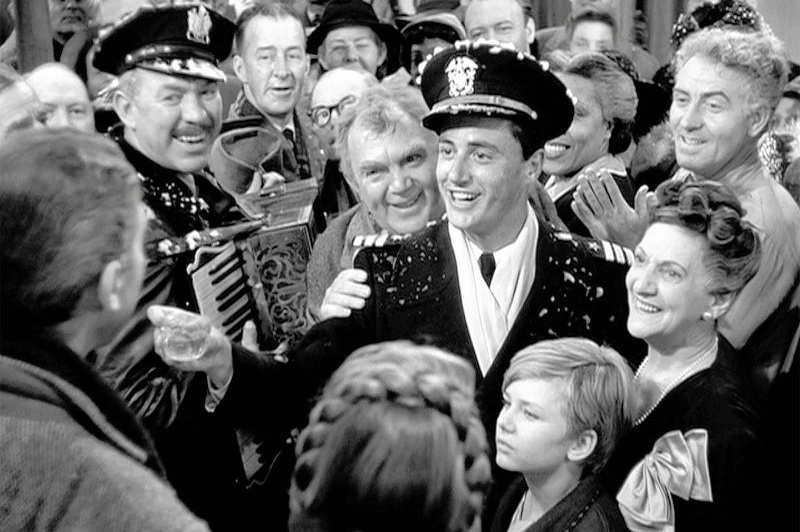Does the American public still have time for ‘Auld Lang Syne’?
The traditional Scottish song long ago achieved ubiquity for its use on New Year’s Eve, when it is sung in observation of the year behind us and the year ahead. Yet its melancholy melody and backward-looking words seem profoundly out of step with contemporary tastes. In fact, apart from the crowds who congregate in Times Square on New Year’s Eve most years, or those wishing to affect a trad or twee persona, it is hard to imagine that too many of us still greet the arrival of the first of the year by launching into a communal rendition of the song.
And this year, with public health officials hoping to corral the coronavirus pandemic by prohibiting large gatherings and actively discouraging overly vivacious group singing, it is a safe bet that we will hear even less of the song than usual among our friends and family.
‘Auld Lang Syne’ itself cautions against the neglect of old friends — ‘Should old acquaintance be forgot, and never brought to mind?’ asks the opening line — but, thanks to Hollywood, the song is in little danger of ever being completely forgotten. Whether or not it’s still sung by ordinary folks on New Year’s Eve, the song remains embedded in the consciousness of anyone with access to a television set or computer screen. Just last month, American Express unveiled a pandemic-themed television spot in which the song was prominently featured, and the number of classic films to use the song as a mood-setter are too many to mention. Just ask Peter Bogdanovich.
Bogdanovich, the 81-year-old director of the classic films The Last Picture Show (1971) and Paper Moon (1973), has used ‘Auld Lang Syne’ just once in his career: the song is memorably heard at the midpoint of the 1985 true-life drama Mask, starring Eric Stoltz as Rocky Dennis, a Southern California teenager whose face was disfigured due to a condition called craniodiaphyseal dysplasia.
In the film’s most touching stretch, Rocky spends a summer volunteering at a camp for the blind, the leaders of which have chosen to mark the new year in July. Bogdanovich pulls out all of the stops for this scene: As Rocky dances with the sightless object of his affection, a girl named Diana (Laura Dern), the counselors and campers around them break into a rendition of — what else? — ‘Auld Lang Syne’. The music heightens the adolescent wistfulness of the scene.
‘The song instantly gives you nostalgia: “Should old acquaintance be forgot” — old acquaintance,’ Bogdanovich told me recently from his home in Los Angeles. ‘It just gives you that feeling of family. I think it brings a tear to everybody’s eyes the minute they hear it.’
Mask is far from most audiences’ idea of typical holiday fare, but the song’s appearance in such an unlikely film suggests just how popular it has become with filmmakers. ‘For some reason, it has a lot of resonance for people, because it’s been used so often as a kind of goodbye or a kind of memory of something,’ said Bogdanovich, also a noted film historian.
Part of the song’s resonance surely comes from its sheer staying power: that redolent opening line seems to have been the handiwork of Scottish poet Robert Ayton (1570-1638), but from there follows something of a muddle. According to the 1910 edition of Grove’s Dictionary of Music and Musicians, the complete words to the song we know today derive from the pen of a much later Scottish poet, Robert Burns (1759-1796), who claimed that he did not actually dream up all of the verses himself but merely recorded language that had been around for a long while. ‘Burns definitely stated that they were old, and that he took them down from the singing of the old man,’ the dictionary says.
Whatever its provenance, after acquiring popularity in Scotland, ‘Auld Lang Syne’ eventually found its way to a burgeoning film industry alert to its cinematic possibilities. Charlie Chaplin was among the first to recognize its inherent contradictions: the song is sung to celebrate a fresh start, but, with its expressions of regret, it often gives singers and listeners alike a sharp rush of sadness. In his 1925 silent film masterpiece The Gold Rush, Chaplin’s ever-disconsolate character listens to, but does not partake in, the singing of the song by a group of nearby revelers. Playing up the song’s lump-in-your-throat qualities, Chaplin helped establish the basic formula for its subsequent use.
In fact, once Hollywood got hold of ‘Auld Lang Syne’, it was loath to let go. The song turned up in countless classic films, from Waterloo Bridge (1940) to An Affair to Remember (1957), and even inspired the very title of John Van Druten’s play Old Acquaintance, later a signature star vehicle for Bette Davis. In more recent times, Nora Ephron’s script to When Harry Met Sally… (1989) has Billy Crystal’s character puzzle over what the verses really mean: ‘My whole life I don’t know what this song means.”’
Of course, ‘Auld Lang Syne’ is a natural choice for scenes set during New Year’s Eve celebrations, but the finest filmmakers of the Golden Age recognized that it could be far more than mere background music. In George Cukor’s brilliant adaptation of Philip Barry’s play Holiday (1938), Cary Grant and Katharine Hepburn play defiant nonconformists who find themselves together in her family home’s play room on New Year’s Eve. At the arrival of midnight, Grant and Hepburn are drawn to the window by the sound of noisemakers. Then, a communal burst from below of ‘Auld Lang Syne’. Cukor uses the song to express the isolation of two loners from the larger swath of seemingly happy merrymakers. As Chaplin first intuited, to hear the song sung by others can be unbearably sad.
Perhaps no film was more in tune with the dulcet melancholy of ‘Auld Lang Syne’ than Billy Wilder’s The Apartment (1960), the masterly comedy-drama starring Jack Lemmon and Shirley MacLaine. In a key late scene, Ms MacLaine’s Fran Kubelik attends a New Year’s Eve party in the company of her good-for-nothing (and married) beau, Jeff D. Sheldrake (Fred MacMurray). As ‘Auld Lang Syne’ is sung by a rowdy crowd, Fran sits deep in thought, mulling her options, and by the time it’s over, Sheldrake turns to find his date having flown the coop: her fresh start is given musical expression by the song itself.
[special_offer]
In the great movie musicals, the characters and plot are too often made second-class citizens to the songs, but in the best non-musical films that make use of ‘Auld Lang Syne’, this particular song deepens the drama — it’s not a break but an enhancement. And, just as it doesn’t have to be New Year’s Eve to sing the song, many directors have trotted it out for non-New Year’s scenes that simply require a touch of emotion.
In John Ford’s Wee Willie Winkie (1937), Shirley Temple warbles the song at the bedside of a mortally ill Victor McLaglen, and in Frank Capra’s It’s a Wonderful Life (1946) — lest we forget, set not on New Year’s Eve but just before Christmas — the residents of Bedford Falls congregate to sing this song (and others) to Jimmy Stewart. In 1983, when Stewart was an honoree on the Kennedy Center Honors broadcast, Carol Burnett led a group performance of ‘Auld Lang Syne’. This was a lovely, almost Proustian moment in modern television, with the song, not unlike a madeleine, serving to link past to present.
‘People know that song as an emotional end-of-something kind of song,’ Bogdanovich told me, but neither changes in musical tastes nor the pandemic should spell the end of this redoubtable song. This New Year’s Eve, those stuck at home could do worse than to cue up a classic film and luxuriate in the tune that has touched so many stars of the silver screen — and perhaps hum along with them.


















